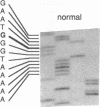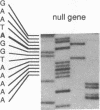Abstract
Hereditary deficiency of complement component C3 in a 10-yr-old boy was studied. C3 could not be detected by RIA of serum from the patient. Segregation of C3 S and C3 F allotypes within the family confirmed the presence of a null gene for C3, for which the patient was homozygous. 30 exons have been characterized, spanning the entire beta chain of C3 and the alpha chain as far as the C3d region. Sequence analysis of the exons derived from the C3 null gene showed no abnormalities in the coding sequences. A GT-AT mutation at the 5' donor splice site of the intervening sequence 18 was found in the C3 null gene. Exons 17-21 were amplified by the polymerase chain reaction (PCR) from first-strand cDNA synthesized from mRNA obtained from peripheral blood monocytes stimulated with LPS. This revealed a 61-bp deletion in exon 18, resulting from splicing of a cryptic 5' donor splice site in exon 18 with the normal 3' splice site in exon 19. This deletion leads to a disturbance of the reading frame of the mRNA with a stop codon 17 bp downstream from the abnormal splice in exon 18. His parents had both the normal and abnormal C3 mRNA and were shown to be heterozygous for this mutation by sequence analysis of genomic DNA amplified by PCR. Similar splice mutants have previously been reported in the beta-globin, phenylalanine hydroxylase, and porphobilinogen deaminase genes. This mutation is sufficient to cause the deficiency of C3 in the patient.
Full text
PDF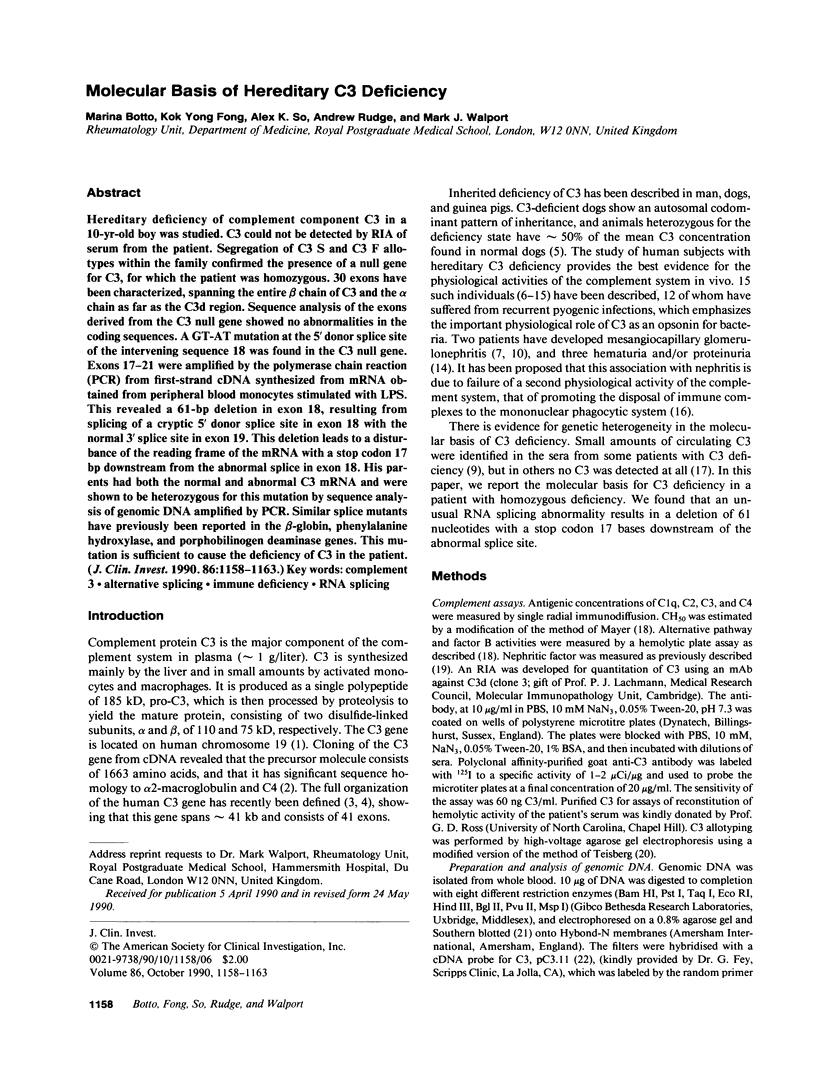
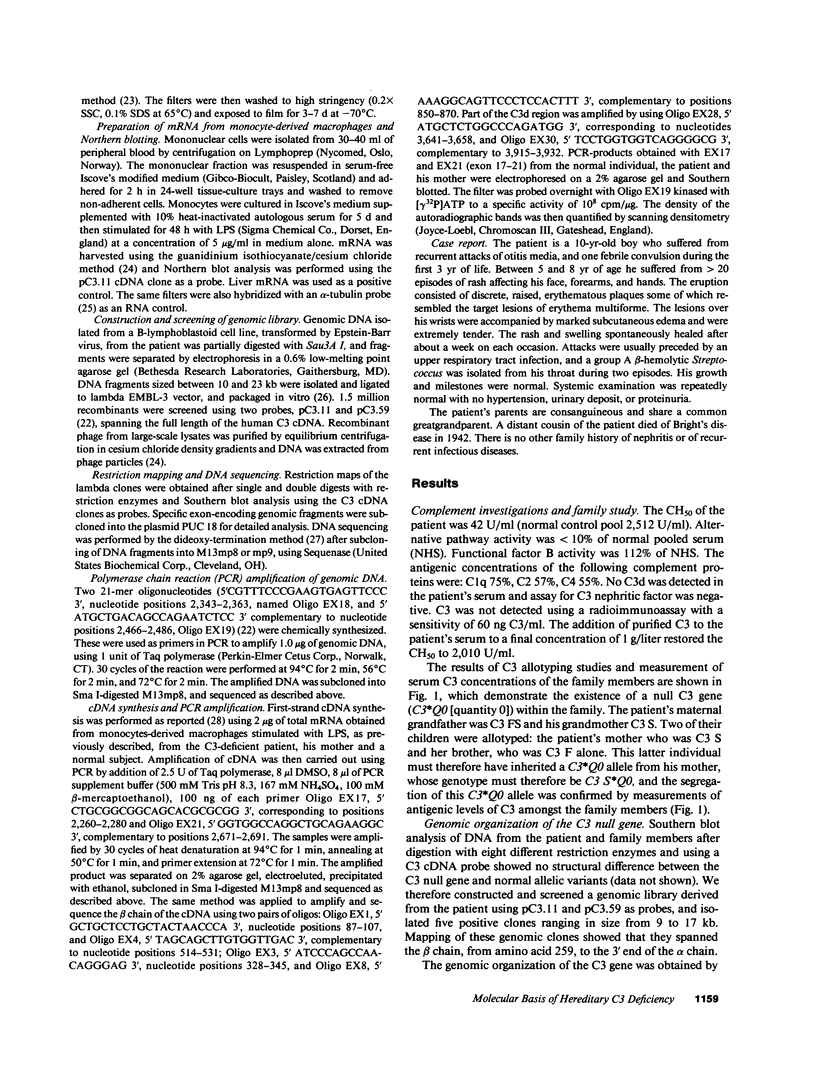
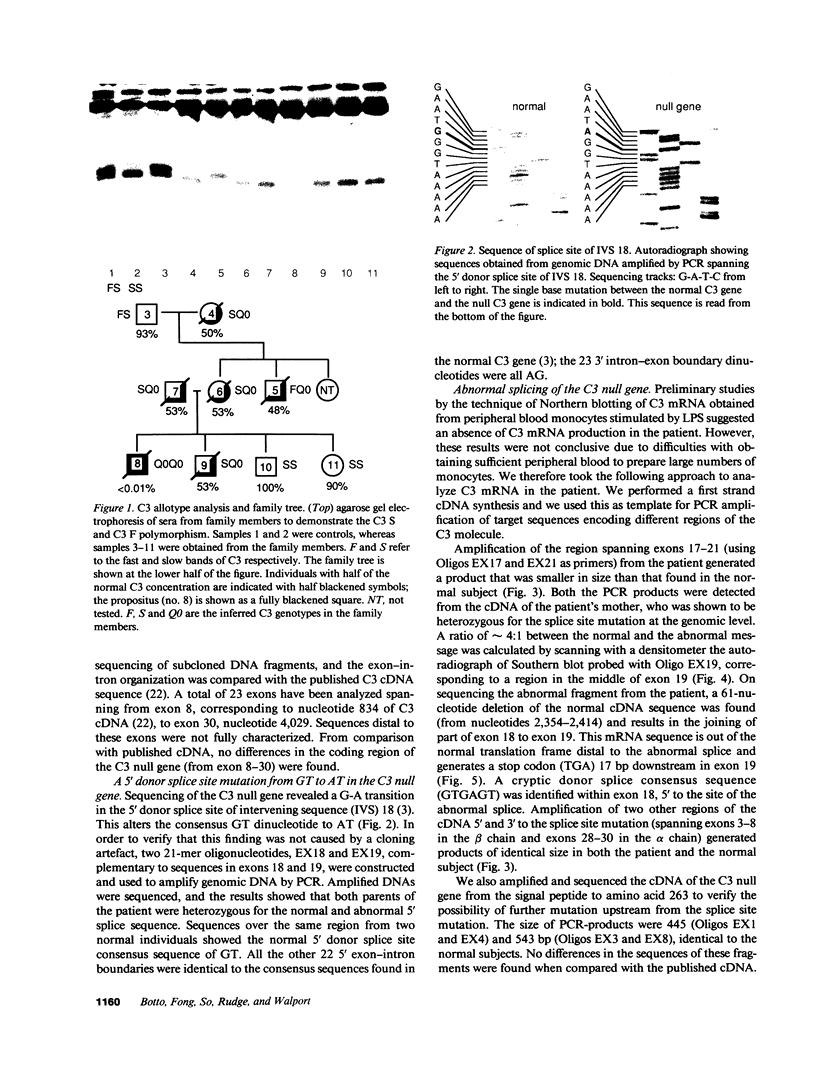
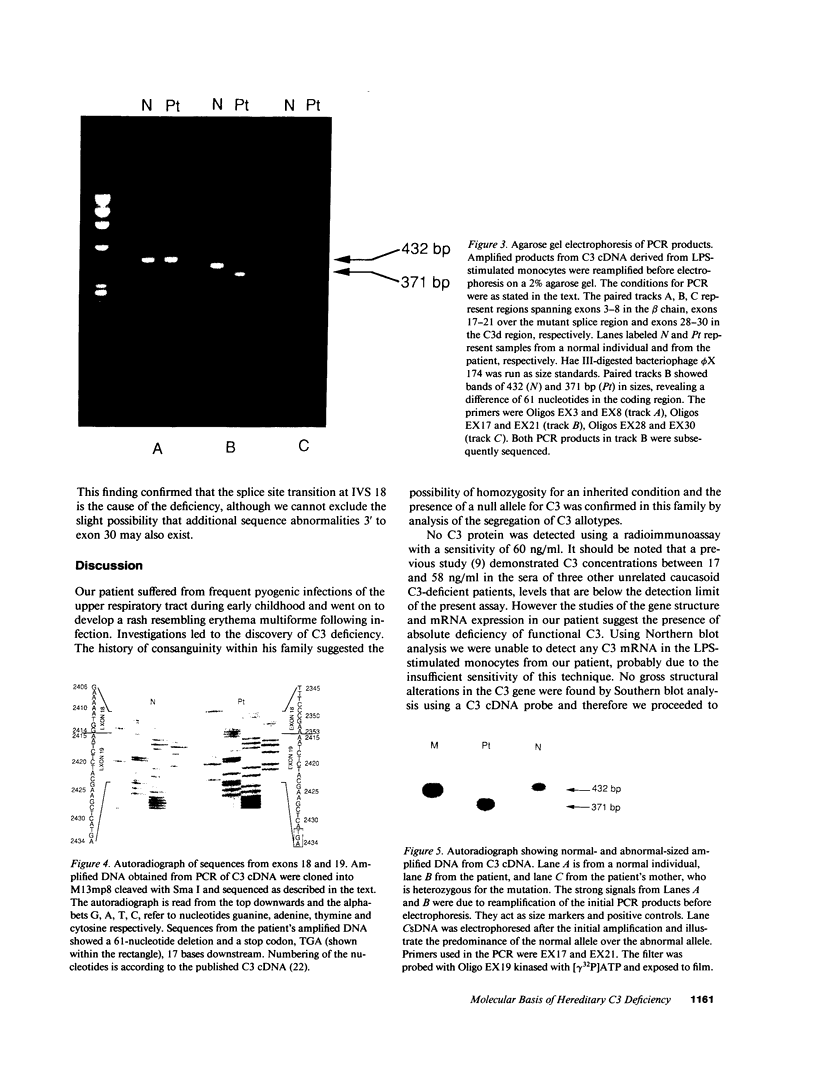
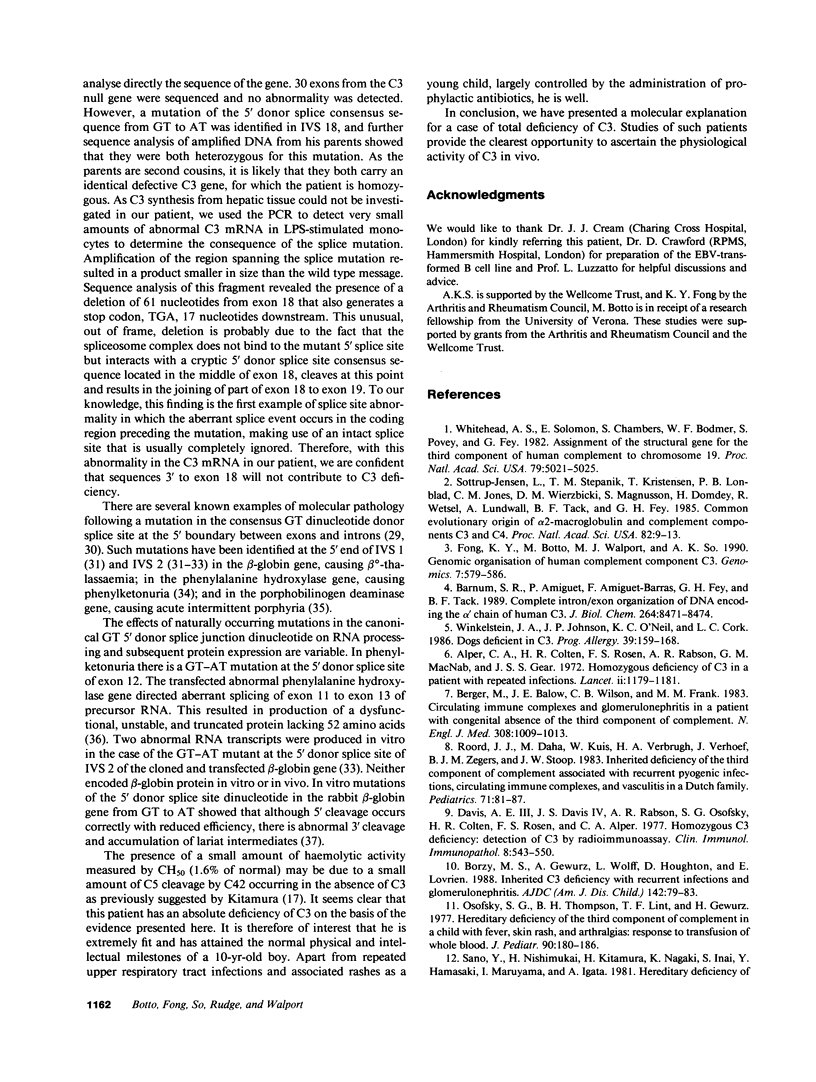
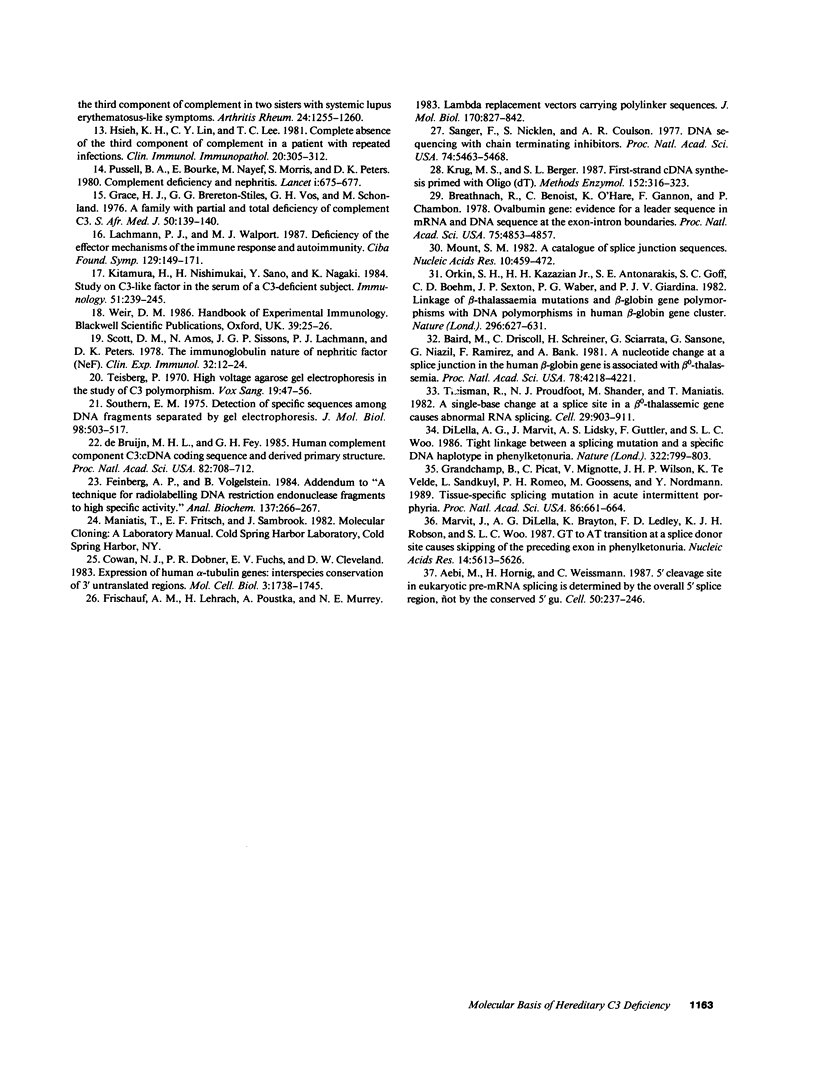
Images in this article
Selected References
These references are in PubMed. This may not be the complete list of references from this article.
- Aebi M., Hornig H., Weissmann C. 5' cleavage site in eukaryotic pre-mRNA splicing is determined by the overall 5' splice region, not by the conserved 5' GU. Cell. 1987 Jul 17;50(2):237–246. doi: 10.1016/0092-8674(87)90219-4. [DOI] [PubMed] [Google Scholar]
- Alper C. A., Colten H. R., Rosen F. S., Rabson A. R., Macnab G. M., Gear J. S. Homozygous deficiency of C3 in a patient with repeated infections. Lancet. 1972 Dec 2;2(7788):1179–1181. doi: 10.1016/s0140-6736(72)92598-6. [DOI] [PubMed] [Google Scholar]
- Baird M., Driscoll C., Schreiner H., Sciarratta G. V., Sansone G., Niazi G., Ramirez F., Bank A. A nucleotide change at a splice junction in the human beta-globin gene is associated with beta 0-thalassemia. Proc Natl Acad Sci U S A. 1981 Jul;78(7):4218–4221. doi: 10.1073/pnas.78.7.4218. [DOI] [PMC free article] [PubMed] [Google Scholar]
- Barnum S. R., Amiguet P., Amiguet-Barras F., Fey G., Tack B. F. Complete intron/exon organization of DNA encoding the alpha' chain of human C3. J Biol Chem. 1989 May 25;264(15):8471–8474. [PubMed] [Google Scholar]
- Berger M., Balow J. E., Wilson C. B., Frank M. M. Circulating immune complexes and glomerulonephritis in a patient with congenital absence of the third component of complement. N Engl J Med. 1983 Apr 28;308(17):1009–1012. doi: 10.1056/NEJM198304283081706. [DOI] [PubMed] [Google Scholar]
- Borzy M. S., Gewurz A., Wolff L., Houghton D., Lovrien E. Inherited C3 deficiency with recurrent infections and glomerulonephritis. Am J Dis Child. 1988 Jan;142(1):79–83. doi: 10.1001/archpedi.1988.02150010089032. [DOI] [PubMed] [Google Scholar]
- Breathnach R., Benoist C., O'Hare K., Gannon F., Chambon P. Ovalbumin gene: evidence for a leader sequence in mRNA and DNA sequences at the exon-intron boundaries. Proc Natl Acad Sci U S A. 1978 Oct;75(10):4853–4857. doi: 10.1073/pnas.75.10.4853. [DOI] [PMC free article] [PubMed] [Google Scholar]
- Cowan N. J., Dobner P. R., Fuchs E. V., Cleveland D. W. Expression of human alpha-tubulin genes: interspecies conservation of 3' untranslated regions. Mol Cell Biol. 1983 Oct;3(10):1738–1745. doi: 10.1128/mcb.3.10.1738. [DOI] [PMC free article] [PubMed] [Google Scholar]
- Davis A. E., 3rd, Davis J. S., 4th, Rabson A. R., Osofsky S. G., Colten H. R., Rosen F. S., Alper C. A. Homozygous C3 deficiency: detection of C3 by radioimmunoassay. Clin Immunol Immunopathol. 1977 Nov;8(3):543–550. doi: 10.1016/0090-1229(77)90019-8. [DOI] [PubMed] [Google Scholar]
- DiLella A. G., Marvit J., Lidsky A. S., Güttler F., Woo S. L. Tight linkage between a splicing mutation and a specific DNA haplotype in phenylketonuria. 1986 Aug 28-Sep 3Nature. 322(6082):799–803. doi: 10.1038/322799a0. [DOI] [PubMed] [Google Scholar]
- Feinberg A. P., Vogelstein B. "A technique for radiolabeling DNA restriction endonuclease fragments to high specific activity". Addendum. Anal Biochem. 1984 Feb;137(1):266–267. doi: 10.1016/0003-2697(84)90381-6. [DOI] [PubMed] [Google Scholar]
- Fong K. Y., Botto M., Walport M. J., So A. K. Genomic organization of human complement component C3. Genomics. 1990 Aug;7(4):579–586. doi: 10.1016/0888-7543(90)90202-6. [DOI] [PubMed] [Google Scholar]
- Frischauf A. M., Lehrach H., Poustka A., Murray N. Lambda replacement vectors carrying polylinker sequences. J Mol Biol. 1983 Nov 15;170(4):827–842. doi: 10.1016/s0022-2836(83)80190-9. [DOI] [PubMed] [Google Scholar]
- Grace H. J., Brereton-Stiles G. G., Vos G. H., Schonland M. A family with partial and total deficiency of complement C3. S Afr Med J. 1976 Jan 31;50(5):139–140. [PubMed] [Google Scholar]
- Grandchamp B., Picat C., Mignotte V., Wilson J. H., Te Velde K., Sandkuyl L., Roméo P. H., Goossens M., Nordmann Y. Tissue-specific splicing mutation in acute intermittent porphyria. Proc Natl Acad Sci U S A. 1989 Jan;86(2):661–664. doi: 10.1073/pnas.86.2.661. [DOI] [PMC free article] [PubMed] [Google Scholar]
- Hsieh K. H., Lin C. Y., Lee T. C. Complete absence of the third component of complement in a patient with repeated infections. Clin Immunol Immunopathol. 1981 Sep;20(3):305–312. doi: 10.1016/0090-1229(81)90140-9. [DOI] [PubMed] [Google Scholar]
- Kitamura H., Nishimukai H., Sano Y., Nagaki K. Study on C3-like factor in the serum of a C3-deficient subject. Immunology. 1984 Feb;51(2):239–245. [PMC free article] [PubMed] [Google Scholar]
- Krug M. S., Berger S. L. First-strand cDNA synthesis primed with oligo(dT). Methods Enzymol. 1987;152:316–325. doi: 10.1016/0076-6879(87)52036-5. [DOI] [PubMed] [Google Scholar]
- Lachmann P. J., Walport M. J. Deficiency of the effector mechanisms of the immune response and autoimmunity. Ciba Found Symp. 1987;129:149–171. doi: 10.1002/9780470513484.ch11. [DOI] [PubMed] [Google Scholar]
- Marvit J., DiLella A. G., Brayton K., Ledley F. D., Robson K. J., Woo S. L. GT to AT transition at a splice donor site causes skipping of the preceding exon in phenylketonuria. Nucleic Acids Res. 1987 Jul 24;15(14):5613–5628. doi: 10.1093/nar/15.14.5613. [DOI] [PMC free article] [PubMed] [Google Scholar]
- Mount S. M. A catalogue of splice junction sequences. Nucleic Acids Res. 1982 Jan 22;10(2):459–472. doi: 10.1093/nar/10.2.459. [DOI] [PMC free article] [PubMed] [Google Scholar]
- Orkin S. H., Kazazian H. H., Jr, Antonarakis S. E., Goff S. C., Boehm C. D., Sexton J. P., Waber P. G., Giardina P. J. Linkage of beta-thalassaemia mutations and beta-globin gene polymorphisms with DNA polymorphisms in human beta-globin gene cluster. Nature. 1982 Apr 15;296(5858):627–631. doi: 10.1038/296627a0. [DOI] [PubMed] [Google Scholar]
- Osofsky S. G., Thompson B. H., Lint T. F., Gewurz H. Hereditary deficiency of the third component of complement in a child with fever, skin rash, and arthralgias: response to transfusion of whole blood. J Pediatr. 1977 Feb;90(2):180–186. doi: 10.1016/s0022-3476(77)80626-4. [DOI] [PubMed] [Google Scholar]
- Pussell B. A., Bourke E., Nayef M., Morris S., Peters D. K. Complement deficiency and nephritis. A report of a family. Lancet. 1980 Mar 29;1(8170):675–677. [PubMed] [Google Scholar]
- Roord J. J., Daha M., Kuis W., Verbrugh H. A., Verhoef J., Zegers B. J., Stoop J. W. Inherited deficiency of the third component of complement associated with recurrent pyogenic infections, circulating immune complexes, and vasculitis in a Dutch family. Pediatrics. 1983 Jan;71(1):81–87. [PubMed] [Google Scholar]
- Sanger F., Nicklen S., Coulson A. R. DNA sequencing with chain-terminating inhibitors. Proc Natl Acad Sci U S A. 1977 Dec;74(12):5463–5467. doi: 10.1073/pnas.74.12.5463. [DOI] [PMC free article] [PubMed] [Google Scholar]
- Sano Y., Nishimukai H., Kitamura H., Nagaki K., Inai S., Hamasaki Y., Maruyama I., Igata A. Hereditary deficiency of the third component of complement in two sisters with systemic lupus erythematosus-like symptoms. Arthritis Rheum. 1981 Oct;24(10):1255–1260. doi: 10.1002/art.1780241005. [DOI] [PubMed] [Google Scholar]
- Scott D. M., Amos N., Sissons J. G., Lachmann P. J., Peters D. K. The immunogloblin nature of nephritic factor (NeF). Clin Exp Immunol. 1978 Apr;32(1):12–24. [PMC free article] [PubMed] [Google Scholar]
- Sottrup-Jensen L., Stepanik T. M., Kristensen T., Lønblad P. B., Jones C. M., Wierzbicki D. M., Magnusson S., Domdey H., Wetsel R. A., Lundwall A. Common evolutionary origin of alpha 2-macroglobulin and complement components C3 and C4. Proc Natl Acad Sci U S A. 1985 Jan;82(1):9–13. doi: 10.1073/pnas.82.1.9. [DOI] [PMC free article] [PubMed] [Google Scholar]
- Southern E. M. Detection of specific sequences among DNA fragments separated by gel electrophoresis. J Mol Biol. 1975 Nov 5;98(3):503–517. doi: 10.1016/s0022-2836(75)80083-0. [DOI] [PubMed] [Google Scholar]
- Teisberg P. High voltage agarose gel electrophoresis in the study of C 3 polymorphism. Vox Sang. 1970 Jul;19(1):47–56. doi: 10.1111/j.1423-0410.1970.tb01494.x. [DOI] [PubMed] [Google Scholar]
- Treisman R., Proudfoot N. J., Shander M., Maniatis T. A single-base change at a splice site in a beta 0-thalassemic gene causes abnormal RNA splicing. Cell. 1982 Jul;29(3):903–911. doi: 10.1016/0092-8674(82)90452-4. [DOI] [PubMed] [Google Scholar]
- Whitehead A. S., Solomon E., Chambers S., Bodmer W. F., Povey S., Fey G. Assignment of the structural gene for the third component of human complement to chromosome 19. Proc Natl Acad Sci U S A. 1982 Aug;79(16):5021–5025. doi: 10.1073/pnas.79.16.5021. [DOI] [PMC free article] [PubMed] [Google Scholar]
- Winkelstein J. A., Johnson J. P., O'Neil K. M., Cork L. C. Dogs deficient in C3. Prog Allergy. 1986;39:159–168. doi: 10.1159/000318543. [DOI] [PubMed] [Google Scholar]
- de Bruijn M. H., Fey G. H. Human complement component C3: cDNA coding sequence and derived primary structure. Proc Natl Acad Sci U S A. 1985 Feb;82(3):708–712. doi: 10.1073/pnas.82.3.708. [DOI] [PMC free article] [PubMed] [Google Scholar]




